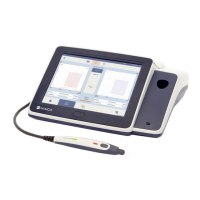Operation Manual
touchTymp MI 24
and
MI 34
Version
1.6.3 Acoustic Reflex
An Acoustic Reflex, or contraction of the stapedial muscle, occurs under normal
conditions when a sufficiently intense sound is presented to the auditory pathway. This
contraction of the muscle causes a stiffening of the ossicular chain which changes the
compliance of the middle ear system. As in Tympanometry, a probe tone is used to
measure this change in compliance.
When the stimulus presentation and measurement are made in the same ear by means
of the probe, this acoustical reflex is referred to as an Ipsilateral Acoustic Reflex.
When the stimulus presentation is made in the opposite ear of where the measurement
is made, this acoustical reflex is referred to as a Contralateral Acoustic Reflex.
For best results, this reflex measurement is automatically conducted at the air pressure
value where the compliance peak occurred during the Tympanometric test. Stimulus
tones of varying intensities at 500 Hz, 1000 Hz, 2000 Hz or 4000 Hz are presented as
short bursts. If a change in compliance greater than the selected value is detected, a
reflex is considered present. Because this is an extremely small compliance change,
any movement of the probe during the test may produce an artifact (false response).
The test result is recorded as Pass/No Response (NR), and in graphical form.
If the Tympanometric results display any abnormal findings, the results of the
Acoustic Reflex testing may be inconclusive and should be interpreted with care.
Theoretically, a compliance peak is necessary to observe a reflex at peak pressure.
1.6.4 Acoustic Reflex Decay (MI 34 Version Only)
Acoustic reflex decay, also known as adaptation, is the measurement of the acoustic
reflex response during sustained stimulus presentation. Ipsilateral and Contralateral
Reflex Decay can be performed.
1.6.5 Eustachian Tube Dysfunction (ETF) (MI 34 Version Only)
The Eustachian tube connects the middle ear with the nasopharynx. Its function is to
equalize pressure between the middle ear and the atmosphere.
The Eustachian tube test can be used to determine if the Eustachian tube is functioning
properly in patients.
ETF Intact: performed on patients with normal tympanic membrane (TM).
ETF Perforated: determines if the patient can open his/her Eustachian tube when
the TM is perforated or an open PE-tube is in place.

